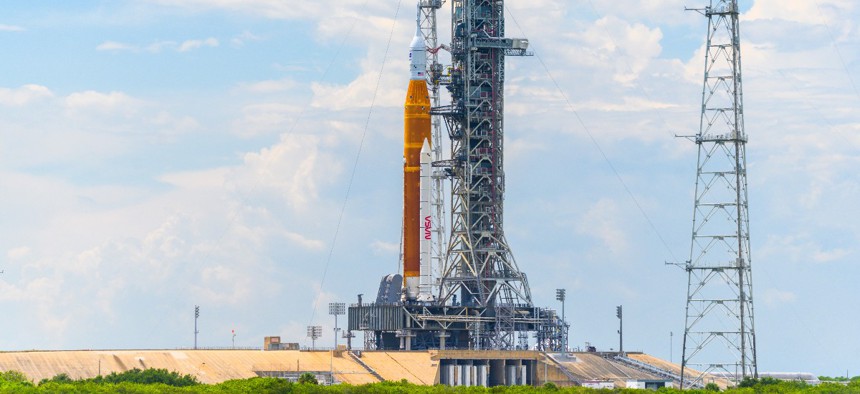Artemis I Launch Scrubbed Following Engine Issues

NASA’s Space Launch System (SLS) rocket with the Orion spacecraft aboard is seen atop the mobile launcher at Launch 39B at NASA’s Kennedy Space Center in Florida. Eric Bordelon/NASA
The soonest the next launch could occur is Friday, if the engine bleed issues are addressed.
The anticipation for NASA’s launch of the Artemis I mission to the moon will continue to grow as a series of obstacles caused the launch’s postponement Monday.
The launch was set to occur within a two-hour window that began at 8:33 a.m. ET at the Kennedy Space Center in Florida, but was pushed back until at least Friday, Sept. 2, as several issues caused the delay.
Specifically, NASA teams must address an issue with an engine bleed, as one out of the four RS-25 engines did not reach the proper temperature. Earlier teams also identified an issue with a hydrogen spike while filling the core stage tanks. The rocket is in a safe configuration as it is assessed for next steps, according to the agency.
“We don’t launch until it’s right,” NASA Administrator Bill Nelson said.
Artemis I is an unmanned test flight. It is the first of several planned Artemis missions, which represent NASA’s effort to return American astronauts to the moon and then to Mars.
On Monday afternoon, NASA leaders provided an update on the day’s launch attempt of Artemis I.
“I’m very proud of this launch team,” Nelson said. “They have solved several problems along the way and they got to one that needed time to be solved.”
“This is a brand new rocket,” Nelson said. “It’s not going to fly until it’s ready. There are millions of components of this rocket and its systems and, needless to say, the complexity is daunting when you bring it all into the focus of a countdown.”
He added that scrubs are “part of the process.”
Mike Sarafin, Artemis I Mission Manager, noted obstacles that the team faced, including a lightning strike, which the team determined the rocket was not impacted by. However, he also noted the team’s awareness of the issue that caused the launch to be scrubbed.
“We talked at our flight readiness review about the engine bleed,” Sarafin said. “We knew that was a risk heading into this launch campaign and it would be the first time demonstrating that successfully.”
Sarafin added, “we did encounter an issue chilling down Engine 3. We need the engine to be at the cryogenically cool temperature, such that, when it starts, it’s not shocked with the cool temperature of the cold fuel that runs through it. So, we need a little extra time to assess that.”
Vice President Kamala Harris, who was originally scheduled to speak at the launch, tweeted, “While we hoped to see the launch of Artemis I today, the attempt provided valuable data as we test the most powerful rocket in history. Our commitment to the Artemis Program remains firm, and we will return to the moon.”
The Government Accountability Office previously issued a report in May 2021, which indicated that there were significant challenges to the agency’s mission to have humans return to the moon by 2024—a timeframe that was pushed back to 2025 after the report was published. GAO also cited management challenges that may hinder the mission, making four recommendations to NASA. The space agency agreed with three of the recommendations for it to “assess off-ramps for an immature Gateway technology and document the process for determining key programmatic and technical tools for the Artemis missions.” NASA disagreed with a recommendation relating to cost estimates.
Meanwhile, in March, GAO issued an update on NASA’s progress, noting that Artemis III—the mission that intends to return U.S. astronauts to the surface of the moon for the first time since 1972—has been postponed by at least a year to 2025. According to the report, NASA “has made progress on preparing for Artemis III (including planning its first test flight), we testified about challenges it faces in meeting its goal.” GAO continued to highlight Artemis’s schedule and costs as challenges to the mission.
NASA said the Artemis I mission management team will meet Tuesday to discuss next steps.






